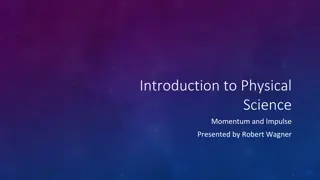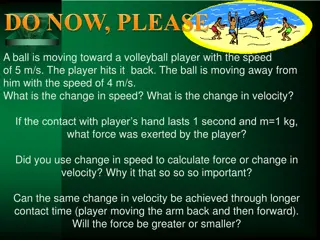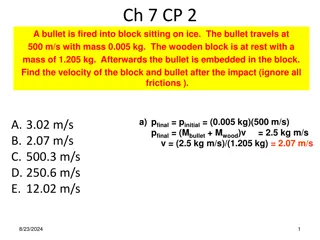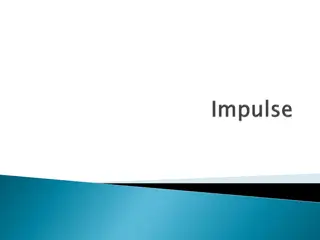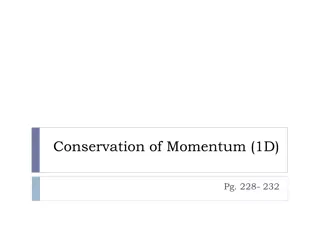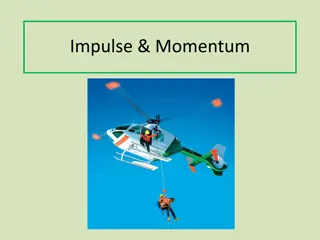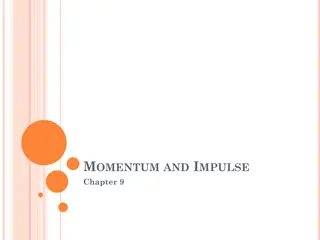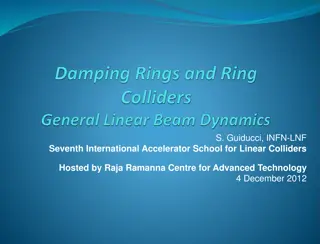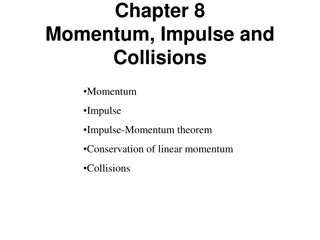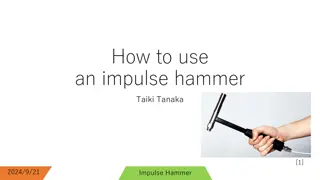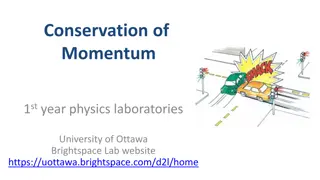Understanding Impulse and Momentum in Particle Motion
Exploring the concept of impulse and momentum in particle dynamics. Learn how these principles are used to solve problems involving force, mass, velocity, and time. Understand the impact of impulsive motion and how it affects the motion of particles in different scenarios.
Download Presentation

Please find below an Image/Link to download the presentation.
The content on the website is provided AS IS for your information and personal use only. It may not be sold, licensed, or shared on other websites without obtaining consent from the author. Download presentation by click this link. If you encounter any issues during the download, it is possible that the publisher has removed the file from their server.
E N D
Presentation Transcript
Unit IV 2 Dynamics Of Particles Review of laws of motion Newton s law Work Energy Equation of particles Impulse and Momentum Impact of elastic bodies. Introduction to vibrations - Single degree of freedom systems with and without damping
3 Impulse and Momentum A third basic method for the solution of problems dealing with the motion of particles is based on the principle of impulse and momentum This can be used to solve problems involving force, mass, velocity, and time. It is of particular interest in the solution of problems involving impulsive motion and problems involving impact This impact test between an F-4 Phantom and a rigid reinforced target was to determine the impact force as a function of time
4 Impulse and Momentum (Contd.) Consider a particle of mass m acted upon by a force F. As seen earlier, Newton s second law can be expressed in the form where mv is the linear momentum of the particle. Multiplying both sides by dt and integrating from a time t1 to a time t2 , we get Transposing the last term, The integral term is a vector known as the linear impulse, or simply the impulse, of the force F during the interval of time considered.
5 Impulse and Momentum (Contd.) The above equation expresses that when a particle is acted upon by a force F during a given time interval, the final momentum mv2 of the particle can be obtained by adding vectorially its initial momentum mv1 and the impulse of the force F during the time interval considered It can be written as When several forces act on a particle, the impulse of each of the forces must be considered. When a problem involves two particles or more, each particle can be considered separately and the above equation can be written for each particle. We can also add vectorially the momenta of all the particles and the impulses of all the forces involved as
6 Impulse and Momentum (Contd.) If no external force is exerted on the particles or, if the sum of the external forces is zero, the second term in the equation vanishes and reduced to A force acting on a particle during a very short time interval that is large enough to produce a definite change in momentum is called an impulsive force and the resulting motion is called an impulsive motion. For example, when a cricket ball is struck, the contact between bat and ball takes place during a very short time interval t. But the average value of the force F exerted by the bat on the ball is very large, and the resulting impulse F t is large enough to change the sense of motion of the ball When impulsive forces act on a particle, the impulse equation becomes
7 Problem 1 An automobile weighing 40 kN is driven down a 5 incline at a speed of60 km/h when the brakes are applied, causing a constant total braking force(applied by the road on the tires) of 15 kN. Determine the time taken by the automobile to come to a stop.
8 Solution to Problem 1 Applying the principle of impulse and momentum Wt Each force is constant in magnitude and direction, each corresponding impulse is equal to the product of the force and of the time interval t. Nt 3 60 10 = = v 16.66 m/s 1 3600 3 (40 10 ) + = 3 16.66 40 10 ( ) 1500 ( ) 0 t t 9.81 67930 68 . = . 1 = 7644 sec t 38500
9 Impact A collision between two bodies which occurs in a very small interval of time and during which the two bodies exert relatively large forces on each other is called an impact. The common normal to the surfaces in contact during the impact is called the line of impact. If the mass centers on the two colliding bodies are located on this line, the impact is a central impact. Otherwise, the impact is said to be eccentric
10 Impact (Contd.) If the velocities of the two particles are directed along the line of impact, the impact is said to be a direct impact If either or both particles move along a line other than the line of impact, the impact is said to be an oblique impact
11 Direct Central Impact Consider two particles A and B, of mass mA and mB, which are moving in the same straight line and to the right with known velocities vA and vB (as shown in Fig. a). If vA is larger than vB, particle A will eventually strike particle B. Under the impact, the two particles, will deform and, at the end of the period of deformation, they will have the same velocity u (as in Fig. b). A period of restitution will then take place, at the end of which, depending upon the magnitude of the impact forces and upon the materials involved, the two particles either will have regained their original shape or will stay permanently deformed. It is needed to determine the velocities v A and v B of the particles at the end of the period of restitution (Fig.c)
12 Direct Central Impact (Contd.) Considering first the two particles as a single system, we note that there is no impulsive, external force. Thus, the total momentum of the two particles is conserved, and we write Since all the velocities considered are directed along the same axis, we can replace the equation obtained by the following relation involving only scalar components: A positive value for any of the scalar quantities vA, vB, v A, or v B means that the corresponding vector is directed to the right; A negative value indicates that the corresponding vector is directed to the left.
13 Coefficient of Restitution To obtain the velocities v A and v B, it is necessary to establish a second relation between the scalars v A and v B . For this purpose, let us now consider the motion of particle A during the period of deformation and apply the principle of impulse and momentum. Since the only impulsive force acting on A during this period is the force P exerted by B (Fig. a), we write, using again scalar components, where the integral extends over the period of deformation. Considering now the motion of A during the period of restitution, and denoting by R the force exerted by B on A during this period (Fig. b), we have where the integral extends over the period of restitution.
14 Coefficient of Restitution (Contd.) The ratio of the magnitudes of the impulses corresponding, respectively, to the period of restitution and to the period of deformation is called the coefficient of restitution and is denoted by e. The value of the coefficient e is always between 0 and 1.(eelastic=1, eplastic=0) It depends to a large extent on the two materials involved, but it also varies considerably with the impact velocity and the shape and size of the two colliding bodies. Substituting for the two impulses and we write A similar analysis of particle B leads to the relation Adding the two Since v B v A represents the relative velocity of the two particles after impact and vA - vB represents their relative velocity before impact, formula expresses that the relative velocity of the two particles after impact can be obtained by multiplying their relative velocity before impact by the coefficient of restitution
15 Problem 2 A 20-Mg railroad car moving at a speed of 0.5 m/s to the right collides with a 35-Mg car which is at rest. If after the collision the 35-Mg car is observed to move to the right at a speed of 0.3 m/s, determine the coefficient of restitution between the two cars.
16 Solution to Problem 2 The total momentum of the two cars is conserved The coefficient of restitution is obtained by writing
17 Two identical cars A and B are at rest on a loading dock with brakes released. Car C, of a slightly different style but of the same weight, has been pushed by dockworkers and hits car B with a velocity of 1.5 m/s. Knowing that the coefficient of restitution is 0.8 between B and C and 0.5 between A and B, determine the velocity of each car after all collisions have taken place.


